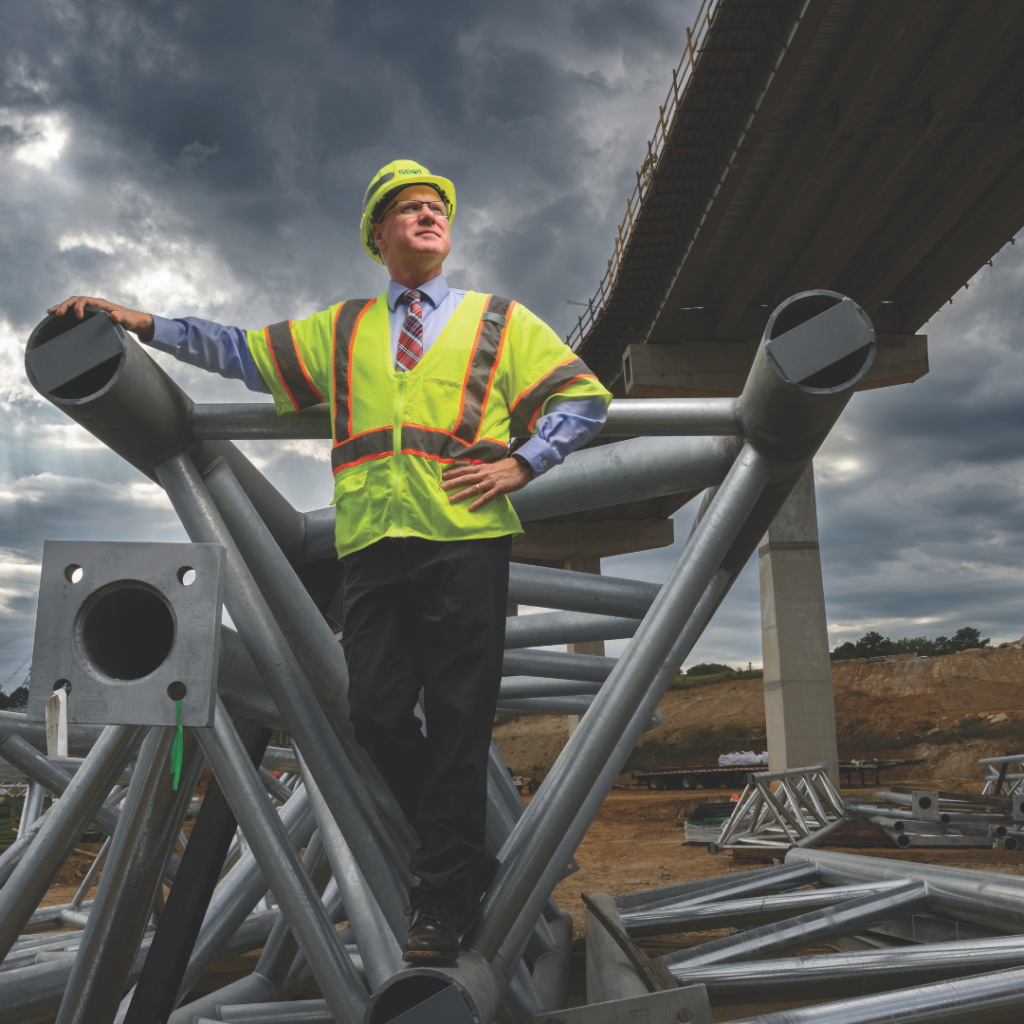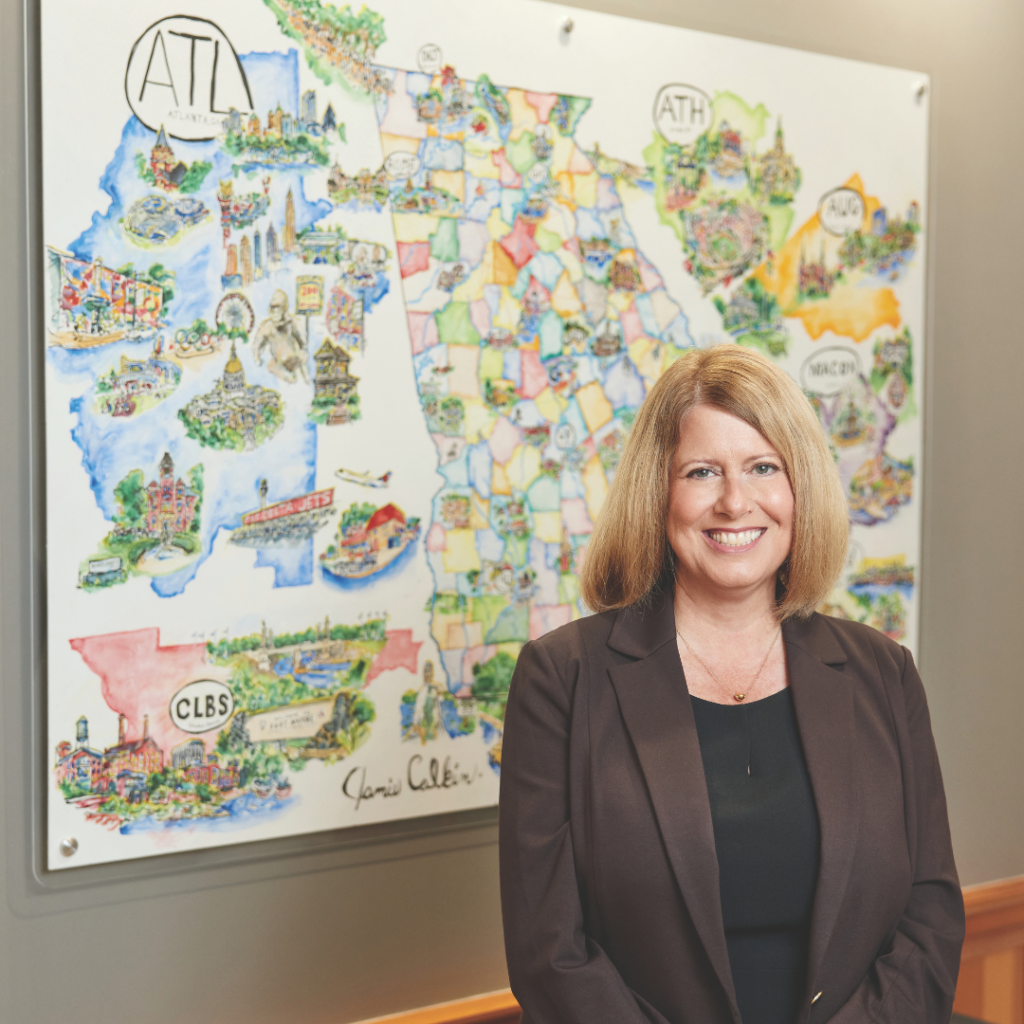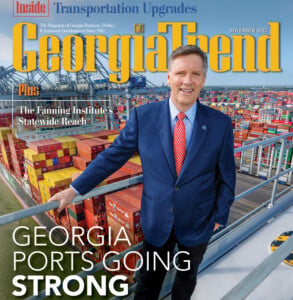Action Oriented
Nonstop infrastructure improvements further strengthen the Georgia ports.
In many ways, the Georgia ports are like a blockbuster action movie: the heroes are smart and strategic, something exciting is always happening and the ultimate goal is making the world a better place – at least the business world.

Game Changer: Kent Fountain, new board chair of the Georgia Ports Authority and president and CEO of Southeastern Gin & Peanut: photo credit Frank Fortune.
Furthermore, as executive producers, the Georgia Ports Authority (GPA) board of directors has long helped ensure the ports’ success through farsighted financing – currently $4.5 billion for the next 12 years. Such financial backing over the past 78 years has helped the Savannah and Brunswick ports grow dramatically with infrastructure improvements that enable capacity to remain ahead of demand.
Case in point: the Savannah port’s two terminals (Garden City and Ocean) have 11.4% market share in container trade among U.S. ports on the east, west and Gulf coasts. That’s up from 7.8% about 10 years ago and means the Savannah port handles nearly one out of every eight loaded twenty-foot equivalent container units (TEUs) in the U.S. At 1,345 acres, it’s now the nation’s single largest and fastest-growing container port.
And the Port of Brunswick has grown to become the nation’s second busiest for import and export of roll on/roll off (Ro/Ro) autos and heavy machinery.
Such achievements have occurred because the Georgia ports rarely have an intermission. This year is no exception.
Trend Spotting
GPA strives to operate at about 80% capacity, maintaining a 20% buffer against spikes in demand due to global economic forces. During the pandemic, much of that buffer was eroded because of elevated consumer spending and supply chain issues. Ships carrying increased numbers of containers swamped many U.S. ports, including Savannah’s. The good news was that record numbers of TEUs passed through the port. The bad news was the strain on resources required to accommodate all the extra business.
Demand has slowed somewhat since FY2022, which was the Savannah port’s all-time busiest year for containers, making now the ideal time to invest in enhancing infrastructure.
“Now’s the time to be able to take advantage of that downturn,” says Kent Fountain, new GPA board chair and president and CEO of Southeastern Gin & Peanut in Surrency, a town in Southeast Georgia. “You can renovate and not create problems and be ready for the next time [a demand spike] happens. That’s why we’re being so aggressive in getting that 20% back.”
Among the projects to increase capacity is the renovation of the Garden City Terminal’s container Berth 1, which was completed and open for business in July. (A berth is the area where a ship moors for loading and unloading cargo.) Berth 1’s renovation included straightening a bend in the Savannah River to enable faster turn times for ocean carriers, increasing the berth’s capacity by 25%.
“We demolished the existing [Berth 1] and physically dredged out material [in the river] to move the land back,” says Griff Lynch, GPA President and CEO. “Now it’s a straight line versus a zigzag. This was a critical thing [to increase the number of big vessels], and we’re very happy that it’s done.”
One mile from the Garden City Terminal, GPA recently premiered the Savannah Transload Facility. This 300,000-square-foot warehouse was built to move goods from containers that arrive at the port to over-the-road trailers or railcars. Initially more than 400 containers a day – totaling 150,000-plus containers annually – will move through the facility and begin their inland trek faster and more efficiently to stores and distribution centers. Because the new facility will deliver greater cargo handling speed and flexibility for customers, Fountain describes it as “the wave of the future.”
He says another advantage of the transload facility is that the containers remain at the port. Fortunately, the port is expanding its capacity to store those containers. The Garden City Terminal West expansion is adding 100 acres of long-term container storage to accommodate 1 million TEUs of annual capacity.
“One of the most frustrating things for an exporter is not to be able to get a box or have the box be tied up somewhere else,” says Fountain, whose company exports cotton and peanuts. “So it’s huge for us to have the ability to have these boxes here and the space for them.”

Increased Capacity: Garden City Terminal’s container Berth 1 was recently renovated: photo credit gaports.com.
In another big-budget production, Savannah’s Ocean Terminal is being remade to be a container-only operation, and GPA’s breakbulk business is moving to the Brunswick port. (Previously Ocean Terminal handled containers and breakbulk cargo – goods that don’t fit in shipping containers or are transported in things like bags, boxes, crates, drums and barrels.) Concentrating on containers in Savannah, and Ro/Ro and breakbulk cargo at Brunswick, is expected to increase efficiencies.
“It’s a win-win,” says Fountain. “It’s streamlining Savannah to be all containers. As far as creating capacity, we’re doing this in advance of the demand. Hopefully, what we’ll see happen is in 2025 – when Ocean Terminal starts opening up in phases – that will give us additional capacity to seamlessly absorb business, as we’ve done in the past.”
Once completed in 2026, Ocean Terminal’s annual capacity is expected to increase to 2 million TEUs.
All the Right Moves
Over at the Port of Brunswick, GPA has recently opened 350,000 square feet of warehousing close to the Colonel’s Island Terminal that will be used for auto and heavy machinery processing. (Some assembly is done on these vehicles, and they are prepared for delivery on site.)

Exceptionally Streamlined: Rory Hepner, director of vehicle logistics and customs operations at the Mercedes-Benz USA headquarters in Sandy Springs: photo credit: Frank Fortune.
And three more buildings with a total of 290,000 square feet, plus 122 acres of Ro/Ro cargo storage space, are coming online on the south side of the terminal. The extra acreage is expanding Brunswick’s annual Ro/Ro capacity from 1.2 million to 1.4 million vehicles.
“What we’re doing in Brunswick is making [what’s now] an incredible facility a flagship facility for North America,” says Lynch. “This facility is the largest in scale of any port in North America for autos and machinery. We’re increasing not only storage capacity for vehicles and machinery but also processing capacity and increasing jobs in that area. This is all new work, not just for the port but also for Brunswick.”
In addition, GPA has received federal approval to build a fourth Ro/Ro berth at Colonel’s Island to better accommodate 7,000-vehicle ships. Lynch says the project will begin next year. “With more ships – as we transfer cargo down there – we definitely [need] to provide an increase in berthing capacity for our customers,” he says.
One of GPA’s all-star customers is Mercedes-Benz USA (MBUSA), which has been exporting and importing vehicles out of Brunswick since 1997. The German automaker is among two dozen major vehicle manufacturers relying on the Colonel’s Island facility. (Nissan North America is the latest to join the cast, choosing Brunswick as a new port of entry last fall.)
Mercedes-Benz sport utility vehicles built in Vance, Ala., are sent to Brunswick by rail for export to countries around the world. And the company’s autos manufactured in other countries enter the U.S. at Brunswick. To process its vehicles, MBUSA owns property at the Brunswick port and has recently expanded its operation.
“This facility is the largest in scale of any port in North America for autos and machinery. We’re increasing not only storage capacity for vehicles and machinery but also processing capacity and increasing jobs in that area. This is all new work, not just for the port but also for Brunswick.” Griff Lynch, executive director, Georgia Ports Authority
“Ships arrive in the country, dedicated to transporting domestic cars for this market,” says Rory Hepner, director of vehicle logistics and customs operations at the MBUSA headquarters in Sandy Springs. “Conversely, ships pick up our export vehicles. This showcases an exceptionally streamlined operational process.
“From both an import and export standpoint, the Georgia port has been one of our very good partners in supporting us with our growth and assisting us and making sure we have the right infrastructure in place,” she adds. “They have always found a way to accommodate and be flexible to help us move our cars.”
Inland Empire
Inland ports can’t exactly be pitched as a new concept. In fact, these dry ports located away from a coast can be found all over the nation. Often, they serve as hubs where cargo loaded onto trains can be transported to and from a coastal port.

Joint Venture: The Appalachian Regional Port is a joint venture with the state, Murray County and CSX Transportation: photo credit gaports.com.
GPA has been an especially avid promoter of the idea. The Appalachian Regional Port (ARP) – the authority’s inland terminal, which is a joint venture with the state, Murray County and CSX Transportation – marked a successful five-year anniversary this year with an 18% increase (5,200 more containers) over FY2022.
“We have a new record in volume for the Appalachian Regional Port: 33,700 containers handled for our fiscal year 2023,” says Lynch. “This is cargo getting off the roads, moving on rail and less trucks. It’s also providing [port] access to customers who may not otherwise have had the chance to do this.”
But what Lynch says is really exciting is the new CSX rail service connecting Murray County to Savannah in 24 hours from departure to arrival. (Formerly it was 72 hours, but the number of containers has now reached critical mass for increased service.) “We’re going to have a significant improvement in connectivity to this area,” he says. “The new service is going to expedite increased volume, so this is huge for the port and for the area.”

Milestone Recognized: Officials from Mercedes-Benz and the Port of Brunswick celebrate the 2 millionth Mercedes-Benz vehicle to depart Colonel’s Island: photo credit gaports.com.
The area extends well beyond North Georgia’s Murray County where the ARP is located. “Companies that are not even in Whitfield and Murray [counties] are able to grow their business north of Atlanta because they can use the ARP,” says Carl Campbell, executive director of the Dalton-Whitfield Joint Development Authority.
“If you put somebody in a truck from Dalton to Savannah, you can’t get there and back in your eight-hour drive-time window,” he says. “But say you’re in Bartow [or] Cherokee County. You can drive your product 30 to 45 minutes north [to the ARP]. It’s a totally different environment from a freight movement standpoint. [The ARP has] added a lot of value, and I think we’re just seeing the tip of the iceberg on that potential.”
Campbell says one thing that perhaps people don’t know is that when the ARP was first announced some locals were skeptical about whether it was a good thing. “[GPA] went to great lengths to build it in a way that is an especially quiet operation,” he says. “Their cranes are electric. They’re not open 24/7 shining bright lights on everybody. For freight coming in, they’re respectful of the church right across the street. So, I think what they’ve done is everything they promised in terms of economic value and more than we should have expected from the standpoint of being a good neighbor.”

Added Value: Carl Campbell, executive director of the Dalton-Whitfield Joint Development Authority. at Appalachian Regional Port: photo credit Kevin Garrett.
That’s good news for Gainesville residents, who will soon see construction begin on the Northeast Georgia Inland Port in Hall County, which will be served by Norfolk Southern railway. With all the regulatory components now in place, the GPA board will vote next month to approve building the new facility. “We’re thinking in 2026 we should be turning the new inland port on up in Gainesville, which is very exciting,” says Lynch.
And plans for an inland port in LaGrange are already underway. GPA has acquired a 200-acre site next to CSX rail that has easy access to Interstates 85 and 185. The facility could eventually serve nearby Kia Motors Manufacturing Georgia and other manufacturers in region.
Unstoppable
Rail transportation is undeniably important for importers and exporters. It’s often faster and more efficient than moving containers on trucks, and it’s a more sustainable alternative that takes trucks off the road.
For Mississippi-based Staplcotn, the oldest and one of the largest cotton marketing co-ops in the U.S., 60% to 80% of cotton exports are sent to Savannah. The organization is a major rail user, according to David Camp, vice president of sales operations. “A large percentage of those containers that we export out of Savannah originate in Memphis and go over CSX and Norfolk Southern,” he says. “The work [GPA has] done on their mega rail project at Savannah to have on-dock rail is a significant advantage to using the port of Savannah.”
The Savannah port’s Mason Mega Rail is North America’s largest on-terminal intermodal facility, located on 85 acres and featuring 18 tracks on which six 10,000-foot freight trains can be loaded simultaneously. The facility was completed two years ago, and it is enabling the port to add 2 million TEUs per year, double the previous intermodal capacity.
Fountain and Lynch both believe the mega rail is the investment that has had the most significant impact on the port.
“There’s nothing like it in this whole country,” says Fountain. “The Mason project is a game changer.”
“It allows us to distinguish or differentiate ourselves from the rest of the pack,” Lynch adds. “There’s no on-dock rail like that remotely close to what we’re offering.”
Staplcotn’s Camp believes the Mason Mega Rail is a great example of GPA’s strategic thinking. “They are strategic thinkers, planners and actors so they can handle not just our volume but all of the volume going through the port, both import and export,” he says. “For us particularly, they’re very agriculture-friendly – they understand that agriculture in the Southeast is very important, and cotton is one of those important exports.”
The nonstop action at the Georgia ports is sure to continue, especially at Savannah with Hyundai Motor Group’s $5.54 billion electric vehicle and battery manufacturing facility under construction in nearby Bryan County. “It’s going to be incredible for the port with the amount of imports and exports that are coming,” predicts Fountain.
Thanks to customer partnerships, strategic thinking, reinvesting revenues to enhance infrastructure and insightful management, there’s never a dull moment at the Georgia ports.








